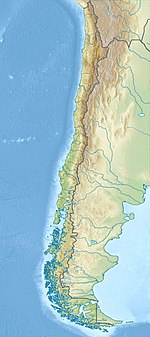| Cura-Mallín Group | |
|---|---|
| Stratigraphic range: Upper Oligocene–Middle Miocene Colhuehuapian-Laventan (SALMA) | |
| Type | Geological group |
| Unit of | Cura-Mallín Basin Neuquén Basin |
| Sub-units | Various schemes, see text |
| Underlies | Cajón Negro Formation Trapa Trapa Formation |
| Overlies | Cretaceous granitoids Jurassic sediments |
| Thickness | >1,800 m (5,900 ft) |
| Lithology | |
| Primary | Sandstone, siltstone, shale, breccia, andesite lava |
| Other | Grainstone |
| Location | |
| Coordinates | 37°42′S 71°12′W / 37.7°S 71.2°W / -37.7; -71.2 |
| Approximate paleocoordinates | 38°18′S 66°24′W / 38.3°S 66.4°W / -38.3; -66.4 |
| Region | Araucanía & Bío Bío Regions Neuquén Province |
| Country | Chile Argentina |
| Type section | |
| Named for | Mallín |
 | |
Cura-Mallín Group (Spanish: Grupo Cura-Mallín) is a heterogeneous group of volcano-sedimentary formations of Oligocene-Miocene age, Colhuehuapian to Laventan in the SALMA classification, in south-central Chile and nearby parts of Argentina. The sediments belonging to the group were deposited in a lacustrine environment and alongside rivers in an intra-arc basin. Southeast of Laguna del Laja Cura-Mallín Group has a thickness of more than 1,800 metres (5,900 ft). The sediments making up the group deposited in an interval between 22 and 8 million years ago.
The outcrops of Cura-Mallín Group are found along a north–south elongate area. The group is considered an equivalent of Abanico Formation, either as a southern extension or as a lateral equivalent of that formation.
Stratigraphy and members
Various subdivision schemes have been proposed for the Cura-Mallín unit since the 1980s. In 1983, Niemeyer and Muñoz identified two members; the Río Queuco Member, overlain by the Malla Malla Member. In two publications published in 1995 and 1997, Suárez and Emperan divided Cura-Mallín Formation in two diachronous members: Guapitrío and Río Pedregoso. Utgé et al. (2009) proposed instead a subdivision into an upper Arroyo Pincheira Member and a lower Lumabia Member.
In a 2017 revision the Cura-Mallín, formerly a formation, was redefined as a group given its great variety of lithologies. The Guapitrío, Río Pedregoso members of Suárez and Emperan became formations according to this scheme. In addition the new scheme include the Mitrauquén Formation that overlies both the Guapitrío and Río Pedregoso Formations as a third formation in the group.
Cura-Mallín Basin
A number of geologists consider Cura-Mallín Basin, the sedimentary basin where the formation deposited, an extensional basin that developed on the western fringes of the much larger Neuquén Basin, while others consider it a back-arc basin. In the Upper Miocene the sedimentary basin was inverted. Relative to other nearby sedimentary basins of Miocene and Oligocene age Cura-Mallín Basin has been more researched.
Fossil content
The group contains abundant mammal fossils including bony fishes, birds and mammals such as rodents, marsupials, Mylodontidaes and Notoungulatas.
Economic geology
See also: Geothermal energy in ChileThe proximity of the Cura-Mallín Group to the stratovolcanoes of Tolhuaca and Lonquimay has made it a reservoir of geothermal energy of interest. Of all units the Rucañanco Member of Guapitrio Formation has been judged to have the most promising reservoir potential.
References
- ^ Suárez & Emparan, 1995
- ^ Utgé et al., 2009
- ^ Pedroza et al., 2017
- ^ Flynn et al., 2008
- Radic, 2010
- Franzese et al., 2011
- Cerro los Pinos at Fossilworks.org
- Trapa Trapa East mid-upper beds at Fossilworks.org
- Estero Trapa Trapa West at Fossilworks.org
- Shockey et al., 2012
- Flynn et al., 2008, p.414
- Cerro Rucañanco at Fossilworks.org
Bibliography
- Flynn, John J.; Charrier, Reynaldo; Croft, Darin A.; Gans, Phillip B.; Herriott, Trystan M.; Wertheim, Jill A.; Wyss, André R. (2008), "Chronologic implications of new Miocene mammals from the Cura-Mallín and Trapa Trapa formations, Laguna del Laja area, south central Chile" (PDF), Journal of South American Earth Sciences, 26 (4): 412–423, Bibcode:2008JSAES..26..412F, doi:10.1016/j.jsames.2008.05.006, retrieved 2017-10-20
- Franzese, Juan R.; D'Elia, Leandro; Bilmes, Andrés; Muravchik, Martin; Hernández, Mariano (2011), "Superposición de cuencas extensionales y contraccionales oligo-miocenas en el retroarco andino norpatagónico: la Cuenca de Aluminé, Neuquén, Argentina", Andean Geology (in Spanish), 38 (2): 319–334, doi:10.5027/andgeoV38n2-a04, retrieved 2016-08-01
- Pedroza, Viviana; LeRoux, Jacobus P.; Gutiérrez, Néstor M.; Vicencio, Vladimir E. (2017), "Stratigraphy, sedimentology, and geothermal reservoir potential of the volcaniclastic Cura-Mallín succession at Lonquimay, Chile", Journal of South American Earth Sciences, 77: 1–20, doi:10.1016/j.jsames.2017.04.011, retrieved 2019-02-15
- Radic, Juan Pablo (2010), "Las cuencas cenozoicas y su control en el volcanismo de los Complejos Nevados de Chillan y Copahue-Callaqui (Andes del Sur, 36-39°S)", Andean Geology (in Spanish), 37 (1): 220–246, retrieved 2016-07-31
- Shockey, Bruce J.; Flynn, John J.; Croft, Darin A.; Gans, Phillip; Wyss, André R. (2012), "New leontiniid Notoungulata (Mammalia) from Chile and Argentina : comparative anatomy, character analysis, and phylogenetic hypotheses", American Museum Novitates (3737): 1–64, doi:10.1206/3737.2, retrieved 2019-02-15
- Suárez, M.; Emparan, C. (1995), "The stratigraphy, geochronology and paleophysiography of a Miocene fresh-water interarc basin, southern Chile", Journal of South American Earth Sciences, 8 (1): 17–31, doi:10.1016/0895-9811(94)00038-4, retrieved 2019-02-15
- Utgé, Silvana; Folguera, Andrés; Litvak, Vanesa; Ramos, Víctor A. (2009), "Geología del sector norte de la Cuenca de Cura Mallín en las Lagunas de Epulaufquen, Neuquén", Revista de la Asociación Geológica Argentina, 64 (2): 231–248, retrieved 2017-10-01
- Geologic groups of South America
- Geologic formations of Chile
- Geologic formations of Argentina
- Miocene Series of South America
- Oligocene Series of South America
- Laventan
- Colloncuran
- Friasian
- Santacrucian
- Colhuehuapian
- Neogene Chile
- Paleontology in Chile
- Geology of Araucanía Region
- Geology of Biobío Region
- Geology of Maule Region
- Geology of Neuquén Province